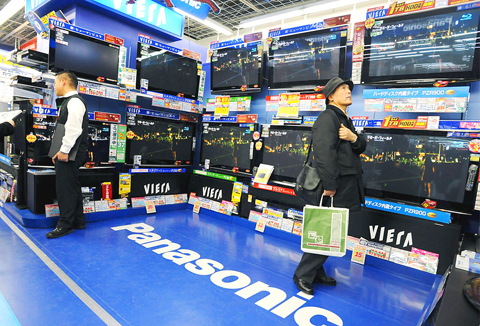Panasonic Corp plans to close three plants in Asia and axe hundreds of jobs as it braces to slip into the red for the first time in six years, a report said yesterday.
The Nikkei Shimbun said Panasonic — bruised by falling electronics prices and the yen’s rise — is expected to report a net loss of around ¥100 billion (US$1.1 billion) in the business year to March.
Mounting restructuring costs will also push losses higher, the daily said, without citing its sources.

PHOTO: EPA
Japan’s electronics giants are facing tougher times after enjoying several years of strong profits, as consumers tighten their purse strings amid recessions in major economies from the US to Japan and Europe. The rising yen has also eroded their export earnings.
Electronics maker Canon Inc said yesterday net profit dropped 37 percent last year and it forecast a further plunge of 68 percent this year because of the global economic crisis.
Canon, which produces cameras and office equipment, logged an annual net profit of ¥309.15 billion, against a year-earlier profit of ¥488.33 billion. For this year it expects a much lower net profit of ¥98 billion.
“The rapid deterioration in the economic environment since the autumn has triggered a global slump in individual consumption. This has caused damage to the digital camera market beyond our expectation,” Canon managing director Masahiro Osawa told reporters.
The Nikkei said Panasonic, which has enjoyed brisk sales of plasma televisions, mobile telephones and digital cameras in recent years, will close two of its three electronics parts facilities in Malaysia.
The two are the Malacca factory, which churns out film capacitors used in mobile phones, and a factory in the state of Selangor, which makes switches for audiovisual equipment.
Panasonic will close the Malacca plant in March with the loss of 500 jobs, it said. The Selangor plant would shut in September, it added, without saying what would happen to the employees there.
A Philippine facility that produces batteries will also be shut in March, with its 60 employees losing their jobs, it said.
Panasonic did not confirm the Nikkei report.
The company said it would announce whether it was revising its full-year forecasts next Wednesday when it releases October-to-last-month results.
In November, the company slashed its net profit forecast for the current financial year by nearly 90 percent, to ¥30 billion.
Panasonic said earlier this month that it would slash investment in flat TVs and exit unprofitable businesses to streamline its operations.

WEAKER ACTIVITY: The sharpest deterioration was seen in the electronics and optical components sector, with the production index falling 13.2 points to 44.5 Taiwan’s manufacturing sector last month contracted for a second consecutive month, with the purchasing managers’ index (PMI) slipping to 48, reflecting ongoing caution over trade uncertainties, the Chung-Hua Institution for Economic Research (CIER, 中華經濟研究院) said yesterday. The decline reflects growing caution among companies amid uncertainty surrounding US tariffs, semiconductor duties and automotive import levies, and it is also likely linked to fading front-loading activity, CIER president Lien Hsien-ming (連賢明) said. “Some clients have started shifting orders to Southeast Asian countries where tariff regimes are already clear,” Lien told a news conference. Firms across the supply chain are also lowering stock levels to mitigate

IN THE AIR: While most companies said they were committed to North American operations, some added that production and costs would depend on the outcome of a US trade probe Leading local contract electronics makers Wistron Corp (緯創), Quanta Computer Inc (廣達), Inventec Corp (英業達) and Compal Electronics Inc (仁寶) are to maintain their North American expansion plans, despite Washington’s 20 percent tariff on Taiwanese goods. Wistron said it has long maintained a presence in the US, while distributing production across Taiwan, North America, Southeast Asia and Europe. The company is in talks with customers to align capacity with their site preferences, a company official told the Taipei Times by telephone on Friday. The company is still in talks with clients over who would bear the tariff costs, with the outcome pending further

Six Taiwanese companies, including contract chipmaker Taiwan Semiconductor Manufacturing Co (TSMC, 台積電), made the 2025 Fortune Global 500 list of the world’s largest firms by revenue. In a report published by New York-based Fortune magazine on Tuesday, Hon Hai Precision Industry Co (鴻海精密), also known as Foxconn Technology Group (富士康科技集團), ranked highest among Taiwanese firms, placing 28th with revenue of US$213.69 billion. Up 60 spots from last year, TSMC rose to No. 126 with US$90.16 billion in revenue, followed by Quanta Computer Inc (廣達) at 348th, Pegatron Corp (和碩) at 461st, CPC Corp, Taiwan (台灣中油) at 494th and Wistron Corp (緯創) at

NEGOTIATIONS: Semiconductors play an outsized role in Taiwan’s industrial and economic development and are a major driver of the Taiwan-US trade imbalance With US President Donald Trump threatening to impose tariffs on semiconductors, Taiwan is expected to face a significant challenge, as information and communications technology (ICT) products account for more than 70 percent of its exports to the US, Chung-Hua Institution for Economic Research (CIER, 中華經濟研究院) president Lien Hsien-ming (連賢明) said on Friday. Compared with other countries, semiconductors play a disproportionately large role in Taiwan’s industrial and economic development, Lien said. As the sixth-largest contributor to the US trade deficit, Taiwan recorded a US$73.9 billion trade surplus with the US last year — up from US$47.8 billion in 2023 — driven by strong